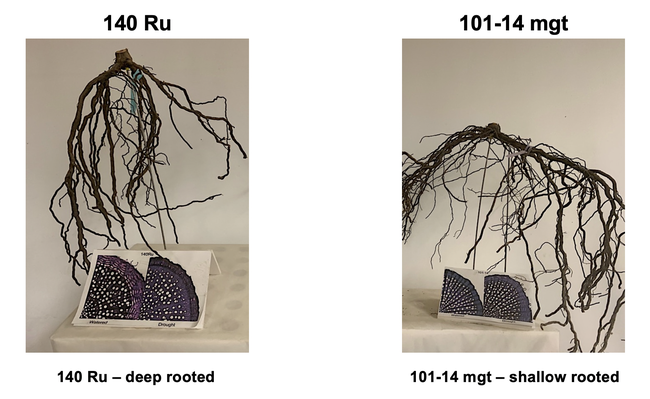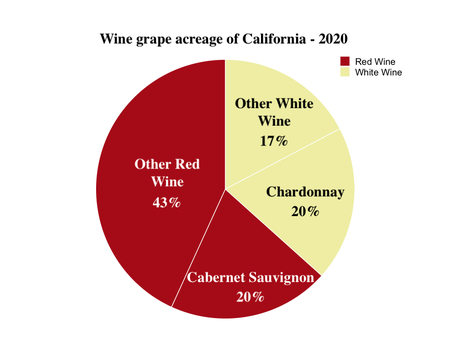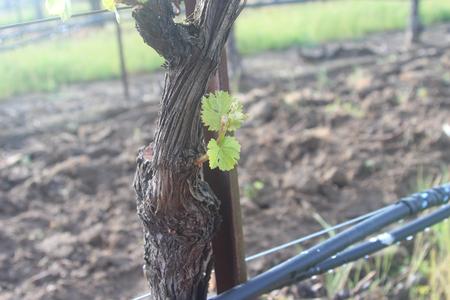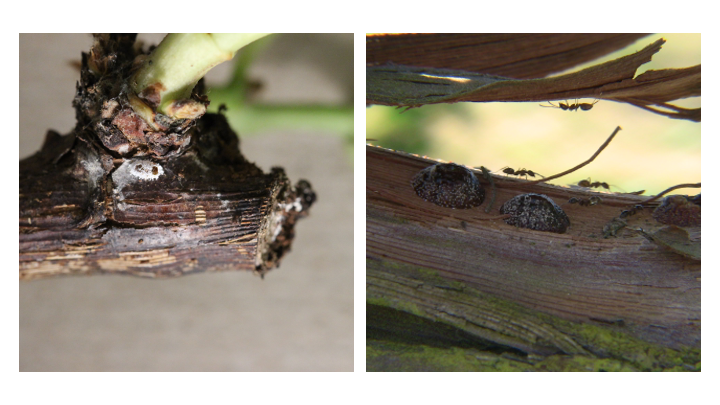April 2022 - Out of Sync
April 2022 – Out of Sync: vineyard responses to changing conditions
Christopher Chen, Ph.D.; Integrated Vineyard Systems Advisor
UC ANR - Sonoma, Lake, and Mendocino Counties
In the 21st century, the most pressing impacts of changing climates have been discussed and shared by scientists, public officials, and media outlets around the world. However, the effect of climate change on peripheral factors of viticulture are sometimes overlooked in the media. The production of any crop is highly time-sensitive practice with the relative success of any farm relying heavily on optimal environmental conditions. Growers of the north coast vineyards of California have become witness to large-scale environmental and climatic changes within their lifetimes.
Over the past four decades, average air temperatures across California have increased by one to two degrees Fahrenheit1 while three out of every four years were considered drought years since the turn of the century2. In a state considered to be an agricultural powerhouse, the observed changes in climate can have enormous impacts throughout the agricultural sector and particularly in vineyards.
Why it’s a problem
While one or two degree increases in temperatures doesn’t immediately seem like a major concern, the hotter days during spring and summer can alter the balance of a vineyard. Within the wide variety of grapevine scions and rootstocks there are individual cultivars or species well adapted to hot and dry climates3,4. Cultivars of Vitis vinifera are in production today which grow better in hot climates such as Zinfandel, and those like Pinot noir that ripen earlier and prefer cooler summer seasons.
Likewise, some rootstocks better adapted to drought conditions than their more water-sensitive counterparts. The root architecture plays a big role in the observed drought tolerance of a grapevine rootstock. Deep rooted cultivars like 140 Ruggeri are adept at searching the soil for additional sources of water while more shallow rooted cultivars like 101-14 Mgt have immediate access to water from drip lines, but not deep in the soil profile.

Comparing the root architecture of two different rootstocks, 140 Ruggeri and 101-14 Mgt, shows the difference in how roots take up water.
Diversifying Varieties

Trends in the markets lead to trends in the vineyard, however we can begin to address concerns with oligo-cultivar vineyards now. Diversifying the cultivars of fruit-bearing grapevines could help improve the resilience of the wine and grape industries to climate change. Nobody expects a production vineyard to remove a block of Cabernet Sauvignon in favor of a more niche variety tomorrow, but if acreage is replanted to less well-known varieties growers have a better chance at finding the next big scion for their respective regions. Changes in climate have been shown to be highly localized and geographically close regions may have vastly different temperature or precipitation patterns in the future. As a result, some varieties may perform well in one appellation, but not in the next one over.
Earlier Development
Over the past few decades as temperatures reached record highs and droughts persisted for longer, annual grapevine development events have begun to occur sooner in the year7. Grapevine development responds to heat accumulation from April to October each year. This heat accumulation is often measured in Growing Degree Days (GDDs) and have been accumulating faster and terminating at higher levels each year as average temperatures increase globally.
Events that typically signal the start of a specific management practice such as flowering, veraíson, or berry maturity, have been observed one or two weeks earlier than four decades ago8. It has become more difficult to predict when management practices will be needed as these events occur sooner each year, making management decisions more difficult for growers. Bud break in early spring has been particularly impacted. Grapevine buds require a certain number of cooling hours in winter to grow adequately in spring. Winter temperatures in California have risen around 2ºF since the 1970s and reduced the chances of adequate chilling hours for vines in warmer climates1.

Ecosystem Asynchrony
In many perennial crops, the whole site can be seen as a functioning ecosystem. In vineyards this holds true as well. Steady irrigation and nutrient applications sustain both the vines and the other organisms present. Insects are often seen as pests in agriculture, however many insect species provide beneficial services to the ecosystem they live in. Predatory mites, parasitoid wasps, lady beetles, and other beneficial insects can help reduce populations of insect pests that feed on grapevine tissues. Generations of beneficial insects often coincide with their prey, helping to maintain pest insect populations within tolerable thresholds.
This synchrony in reproduction is a core component of some integrated pest management strategies. However, changes in temperature and atmospheric CO2 levels have impacted the timing of generational cycles of insect species in vineyards8,9,10. If shifts in the timing of reproduction differ between pest and beneficial insect species, the synchrony between pest and predator could be eliminated. The impacts on pest control that predatory species have could decline along with the population of beneficial insect species.

Mealybug on a grapevine and ants tending to scale insects.
Like many problems, understanding the vineyard ecosystem is key to addressing pest management concerns in a changing climate. Observing the population sizes and developmental rates of important beneficial and pest insect species can help growers better estimate the pest pressure in their vineyards. As insect populations are likely to change with climate, close observation is highly recommended. Speak with your local UC ANR Viticulture or IPM Advisors if you have questions about your vineyard ecosystem.
Adapting to a new climate
The writing on the wall suggests that agriculture as-a-whole will need to adapt to new environmental conditions. In vineyards, higher temperatures, less available water, and increased atmospheric carbon dioxide levels are likely to impact the vines, the ecosystem, and management decisions in the coming decades. So, what can growers do to prepare?
Plant diverse varieties
While average temperatures and atmospheric CO2 levels are increasing around the world, environmental changes are likely to vary at the local level and have the most impact on viticulture. The proliferation of grapevines for food and drink has resulted in many cultivars of the single species, Vitis vinifera, that are adaptable to arid growing conditions. An increase in the number of planted wine grape varieties could help diversify vineyards on a regional scale and improve the adaptability of grapevines to localized climate change.
Monitor the weather
Each year, growers and managers should monitor the average air temperatures, precipitation levels, and other environmental factors relevant to grape production. The unpredictability of climate change impacts can make management decisions more difficult. However, regular monitoring and utilizing prediction models can alleviate the strain placed on vineyard management decisions. Precision viticulture practices are already utilized to manage grapes on a block-by-block, or even vine-by-vine basis.
Observe and record
The timing of seasonal growth and development of grapevines and insects has shifted as climates have changed creating an asynchrony in the vineyard ecosystem. Carefully observing and recording the changing trends in living organisms is an important component to climate adaptation. Keep track of what insects are in your vineyard, when they show up, and how dense their populations are.
Conclusion
As an industry, viticulture is still trying to adapt to a changing climate. Diversifying cultivars and monitoring of the situation are good tools to better prepare for new conditions. As the world changes, agricultural practices should too. Precision viticulture developments are a promising avenue but taking actions now can help reduce the costs of hotter and drier summers. If you would like to talk about preparing your vineyard for a changing climate please contact your local UC ANR Cooperative Extension Viticulture Advisor.
1 Pathak, T.B., M.L. Maskey, J.A. Dahlberg, F. Kearns, K.M. Bali, and D. Zaccaria. “Climate change trends and impacts on California agriculture: A detailed review,” Agronomy, vol. 8, 2018.
2 NDMC, USDA, NOAA. 2022. Drought in California from 2000-present.
3 Serra I, Strever A, Myburgh PA, and Deloire A. 2014. Review: the interaction between rootstocks and cultivars (Vitis Vinifera ) to enhance drought tolerance in grapevine. Australian Journal of Grape and Wine Research, 20: 1-14.
4 Xu H, Liu G, Liu G, Yan B, Duan W, Wang L, and Li S. 2014. Comparison of investigation methods of heat injury in grapevine (Vitis) and assessment to heat tolerance in different cultivars and species. BMC Plant Biology, 14: 156.
5 Volpe RJ, Green R, Heien D, and Howitt R. 2010. Wine-grape production trends reflect evolving consumer demand over 30 years. California Agriculture, 64.
6 CDFA. (2020). California grape acreage report 2020 crop.
7 Wolfe DW, Schwartz MD, Lakso AN, Otsuki Y, Pool RM, and Shaulis NJ. 2005. Climate change and shifts in spring phenology of three horticultural woody perennials in northeastern USA. International Journal of Biometeorology, 49: 303-309
8 Tomasi, D., G. Jones, M. Giust, L. Lovat, and F. Galotti. “Grapevine phenology and climate change: Relationships and trends in the Veneto region of Italy for 1964–2009.” J. of Enol. & Vit., vol. 62, p. 329, 9 2011.
9 Caffarra A, Rinaldi M, Eccel E, Rossi V, and Pertot I. 2012. Modelling the impact of climate change on the interaction between grapevine and its pests and pathogens: European grapevine moth and powdery mildew. Agriculture, Ecosystems Environment, 148: 89-101.
10Skendzíc S, Zovko M, Zivkovíc IP, Lesíc V, and Lemíc D. 2021. The impact of climate change on agricultural insect pests. Insects, 12(5).

